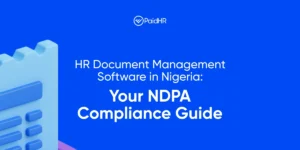Imagine your first payday on a new payroll system. It’s 5 PM on the 25th. Every salary has landed, every tax & statutory Naira is in the right accounts, and your phone isn’t ringing with employee complaints.
This effortless reality is possible, but it doesn’t happen by accident. It happens by anticipating the chaos before it arrives.
Unlike standard payroll implementation guides, we’re not here to give you another generic list that ignores the complex reality of running a business in Nigeria.
Having helped hundreds of Nigerian businesses make the switch, we know exactly where the cracks usually appear. Instead of waiting for them to happen, we will look at the hard truths together so you don’t have to face them later.
5 Major Roadblocks to a Smooth Payroll Implementation
In this guide, we’ll walk through the five most common hurdles that derail Nigerian payroll implementation projects and give you the practical, insider fixes to clear them effortlessly.
1. The Data Trap (When “Good Enough” Records Aren’t Enough)
We know how it is. Your employee data currently lives in three different spreadsheets, a few WhatsApp messages, and perhaps a physical file cabinet in the HR office. For years, this has been “good enough” to get by.
But when you migrate to a modern, automated system, “good enough” data becomes a critical failure point. You cannot migrate chaos and expect clarity.
For a manual system, a human bank officer might have ignored slight name mismatches like paying ‘Tunde Adebayo’ when the account is ‘Babatunde Emmanuel Adebayo.’
Automated systems don’t have that flexibility. If your data doesn’t perfectly match the bank’s official records, the payment will likely fail on your very first automated run.
Beyond immediate payments, poor data leads to long-term liabilities. If an employee’s Pension Fund Administrator (PFA) PIN is wrong in your old records, migrating that error means months of uncredited contributions.
The money leaves your account but never reaches theirs, creating a future administrative nightmare.
How to Fix Your Data Before You Start
Before you choose a payroll implementation date, you need to trust your data.
- Bring it all together: Stop working from multiple files. Consolidate everything into one master “source of truth” spreadsheet.
- Match names to official IDs: “Tunde Adebayo” on your payroll won’t work if his bank account is officially “Babatunde Emmanuel Adebayo.” Ensure they match perfectly.
- Verify government numbers now: Don’t just assume you have every TIN and Pension PIN. Verify them before you move them. It’s tedious work today, but it protects your people and your company tomorrow.
2. The Headcount Trap (Paying ‘Phantom’ Employees)
It happens to the best companies. A contract staff member left three months ago, but finance was not notified, so they are still on a forgotten spreadsheet. Or perhaps a duplicate entry was created when someone changed roles.
In a manual system, these ghosts can hide in the crowd. When you migrate, you risk bringing them with you and paying them automatically.
Small and medium-sized businesses are particularly vulnerable here.
According to the Association of Certified Fraud Examiners’ 2024 global report, businesses with fewer than 100 employees are 1.5 times more likely to experience payroll fraud (which includes “ghost worker” schemes) than larger organisations.
Without the rigid, multi-layered controls of massive corporations, these administrative slips often go unnoticed for months or even years.
And for many companies, this data migration becomes the first time anyone has truly audited the active headcount against the payroll list.
30-Minute “Headcount Reality Check”
You do not need a complex forensic audit to catch 90% of these issues. You just need a simple, practical check.
- Pull the HR List: Get your current, active employee list from your HR records (the people who should be here).
- Pull the Payment List: Get the actual payment list from your last payroll run (the people who got paid).
- Compare Both: Go line by line.
Any name that does not match perfectly needs an immediate investigation.
This simple 30-minute task, reconciling what HR knows with what Finance pays, can save you millions in wasted salary payments during your first automated run.
3. The Compliance Trap (When Your New Software Doesn’t Understand Nigerian Tax)
Nigeria’s tax landscape is unique and complex. A generic, global payroll software might handle basic percentages perfectly, but it often fails the specific tests of Nigerian statutory compliance.
The biggest trap for modern, remote-friendly SMEs is the “Residency Rule.” If your company is in Lagos but you have staff working remotely from Ogun or Oyo state, their PAYE must be remitted to their resident state, not your head office state.
State tax authorities like the LIRS are aggressively digitising to catch these mis-remittances, with its e-Tax portal enabling better tracking of compliance gaps.
Furthermore, generic tools often lack the nuance for recent regulatory changes. For instance, the National Housing Fund (NHF) contribution is now voluntary for private sector employees.
A rigid global system that forces a mandatory 2.5% deduction for everyone puts you at legal risk, while one that does not support it at all denies your staff access to mortgage loans.
And remember the cost of getting this wrong: PenCom penalties for non remittance start at 2% of the unremitted amount for every month you are late. It compounds fast.
How to Check for True Local Compliance
Do not just ask if the software “handles tax.” Ask these specific questions to understand if it truly fits the Nigerian landscape:
- Multi-State Intelligence: Does it automatically handle the PAYE Residency Rule? Can it split remittances across different states without you doing it manually?
- PFA Flexibility: Can it easily remit to all 20+ Pension Fund Administrators at the same time, or will you need manual workarounds for less common ones?
- Statutory Nuance: Are toggles for voluntary contributions (like NHF) built-in? Can it correctly calculate and manage specific levies like the Industrial Training Fund (ITF)?
4. The Payday Crisis (When Rushed Testing Goes Live)
The single biggest mistake in any payroll implementation is rushing the testing phase. You run one test payroll, it looks “close enough,” and you approve the “go-live.”
Then, on the real payday, you discover senior staff pension deductions are wrong and new hires have not been paid at all.
In Nigeria, testing isn’t just about checking calculations; it’s about testing disbursement. Section 5 of the Nigerian Labour Act makes it legally difficult to “claw back” overpayments from employees without explicit consent.
In today’s economy, if you overpay someone on Friday, that money is likely gone by Monday. It is far safer to delay your launch than to launch with errors.
Furthermore, you must test the “last mile” of payment. Can the system’s payment gateway handle the load on the 25th of the month when NIBSS networks are congested?
How to Test Without Doubling Your Work
The “gold standard” advice is to run a full “parallel payroll,” but we know that is not a practical option for a busy SME. It can double the work during an already high stress period.
A more realistic approach is to do a focused “Offline Test Run.”
Here is how:
- Use Last Month’s Data: Take your last month’s final, correct payroll data. This is your “control” group.
- Process it in the New System: Run that exact same data (hours, new hires, leavers from that month) through your new software.
- Compare Key Cohorts: You do not need to check every single employee. Create a “test group” of 10 to 15 staff that includes:
- A senior manager (complex pay, high deductions).
- A new hire (pro-rated salary).
- A junior staff member.
- Someone with a loan deduction.
- Someone who took leave.
- Check Every Line: For this group, compare their new payslip to the old one line by line. If Kemi’s tax deduction is N50 higher, find out why. Is it a configuration error, or was your old spreadsheet actually wrong for years?
This offline check gives you 99% of the confidence of a full parallel run with a fraction of the stress.
5. The Human Pushback (Why Your Team Is Anxious)
You have built a perfect system, but your team might still resist it.
In our current economic climate, employees are understandably anxious about their income. Every Naira counts.
If a new system feels unfamiliar, opaque, or hard to access, they will not see it as an “upgrade”, they will see it as a risk to their livelihood.
Resistance often comes from simple friction. If your new self-service portal is not mobile-friendly, you have already created a major roadblock to adoption.
Your staff won’t wait until they are at a desk to check if their overtime was paid; they want to check it on their phone while sitting in traffic on the Third Mainland Bridge.
This is why a truly mobile-first experience, like the PaidHR app, is no longer a “nice-to-have”, it is essential for buy-in.
How to Earn Trust and Drive Adoption
Change is stressful, especially when it involves people’s pay. Earning trust is your first priority for driving adoption.
- Focus on Transparency and Value: Do not just announce the change; explain what is in it for them. This could be the empowerment of seeing their pay accumulate daily with Earned Wage Access (EWA), the dignity of applying for loans directly on the platform (a benefit that goes beyond just standard payroll), or clearer visibility into their pension savings.
- Empower Internal Champions: Every office has a few people who are curious about new technology. Identify them early, train them first, and let them be the go-to support for their colleagues. Peers trust peers, and this builds confidence from within.
- Establish Clear Feedback Channels: Financial anxiety is real. Provide a clear, safe channel (like a dedicated email or a Q&A session) for them to ask questions about the new system without fear of judgement. Listening to concerns is the fastest way to build trust.
Payroll Implementation Does Not Have to Be a Crisis
A smooth payroll implementation is not about luck; it is about honest preparation. By facing these five hurdles before they happen, you are already ahead of 90% of businesses.
But you do not have to do it alone.
Navigating this complex reality is exactly what we are built for. PaidHR was designed specifically for the African context, and we provide a dedicated implementation team to support you at every stage. Our experts will hold your hand through the entire process, from cleaning your data to training your team, ensuring you get it right from day one.
Ready for an implementation that actually works? Contact us today to get started.
Frequently Asked Questions (FAQs)
1. What is payroll implementation?
Payroll implementation is the complete process of setting up and launching a new payroll software for your company.
It involves everything from moving your employee data out of old spreadsheets, configuring the new system to follow Nigerian tax laws, testing to make sure it is 100% accurate, and training your team to use it.
2. How long does a payroll implementation take?
While the general timeline can vary, our dedicated implementation team typically gets a new SME fully set up within 1 to 2 weeks.
The exact time depends on factors like the size of your company, any custom software integrations, and how ready your employee data is for the switch.
3. What is the most difficult part of payroll implementation in Nigeria?
From our experience, there are two major hurdles. First is the data clean-up. Many businesses underestimate how much time it takes to fix years of inconsistent records.
Second is choosing the wrong partner. Many projects fail because a business chose generic, global software, and they only discover during implementation that it cannot handle the nuances of multi-state PAYE or pension remittances.
This creates a roadblock the user cannot fix. It is why we built PaidHR to be locally compliant from the ground up, so this hurdle is already solved for you before you even start.
4. My data is a complete mess. Where do I even start?
You are not alone; this is the most common starting point. It is a step-by-step process, and it can feel overwhelming.
This is why PaidHR provides a dedicated implementation team to guide you and help you get your data ready for a smooth transition.
If you want to get a head start, here is the process we recommend:
- Start by creating one single “master spreadsheet.”
- Focus only on getting your active employee list 100% correct.
- Next, focus on matching every employee’s name to their official bank/BVN name.
- Finally, tackle the statutory data (TIN and Pension PINs).
5: What is a ‘parallel run’ and is it essential?
A “parallel run” means processing your payroll on both your old system and your new system at the same time to compare the results.
As we mentioned, while it is the “gold standard,” it is often impractical for SMEs. We recommend the “Offline Test Run” (using last month’s data) as a more practical and just-as-safe alternative.





